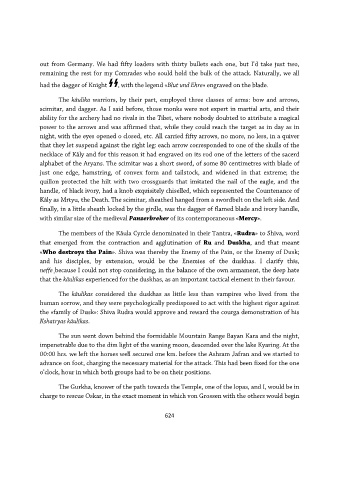Page 624 - Microsoft Word - Belicena respaldo
P. 624
out from Germany. We had fifty loaders with thirty bullets each one, but I’d take just two,
remaining the rest for my Comrades who sould hold the bulk of the attack. Naturally, we all
had the dagger of Knight , with the legend «Blut und Ehre» engraved on the blade.
The kâulika warriors, by their part, employed three classes of arms: bow and arrows,
scimitar, and dagger. As I said before, those monks were not expert in martial arts, and their
ability for the archery had no rivals in the Tibet, where nobody doubted to attribute a magical
power to the arrows and was affirmed that, while they could reach the target as in day as in
night, with the eyes opened o closed, etc. All carried fifty arrows, no more, no less, in a quiver
that they let suspend against the right leg: each arrow corresponded to one of the skulls of the
necklace of Kâly and for this reason it had engraved on its rod one of the letters of the sacerd
alphabet of the Aryans. The scimitar was a short sword, of some 80 centimetres with blade of
just one edge, hamstring, of convex form and tailstock, and widened in that extreme; the
quillon protected the hilt with two crossguards that imitated the nail of the eagle, and the
handle, of black ivory, had a knob exquisitely chiselled, which represented the Countenance of
Kâly as Mrtyu, the Death. The scimitar, sheathed hanged from a swordbelt on the left side. And
finally, in a little sheath locked by the girdle, was the dagger of flamed blade and ivory handle,
with similar size of the medieval Panzerbreher of its contemporaneous «Mercy».
The members of the Kâula Cyrcle denominated in their Tantra, «Rudra» to Shiva, word
that emerged from the contraction and agglutination of Ru and Duskha, and that meant
«Who destroys the Pain». Shiva was thereby the Enemy of the Pain, or the Enemy of Dusk;
and his disciples, by extension, would be the Enemies of the duskhas. I clarify this,
neffe¸because I could not stop considering, in the balance of the own armament, the deep hate
that the kâulikas experienced for the duskhas, as an important tactical element in their favour.
The kâulikas considered the duskhas as little less than vampires who lived from the
human sorrow, and they were psychologically predisposed to act with the highest rigor against
the «family of Dusk»: Shiva Rudra would approve and reward the courga demonstration of his
Kshatryas kâulikas.
The sun went down behind the formidable Mountain Range Bayan Kara and the night,
impenetrable due to the dim light of the waning moon, descended over the lake Kyaring. At the
00:00 hrs. we left the horses well secured one km. before the Ashram Jafran and we started to
advance on foot, charging the necessary material for the attack. This had been fixed for the one
o’clock, hour in which both groups had to be on their positions.
The Gurkha, knower of the path towards the Temple, one of the lopas, and I, would be in
charge to rescue Oskar, in the exact moment in which von Grossen with the others would begin
624

